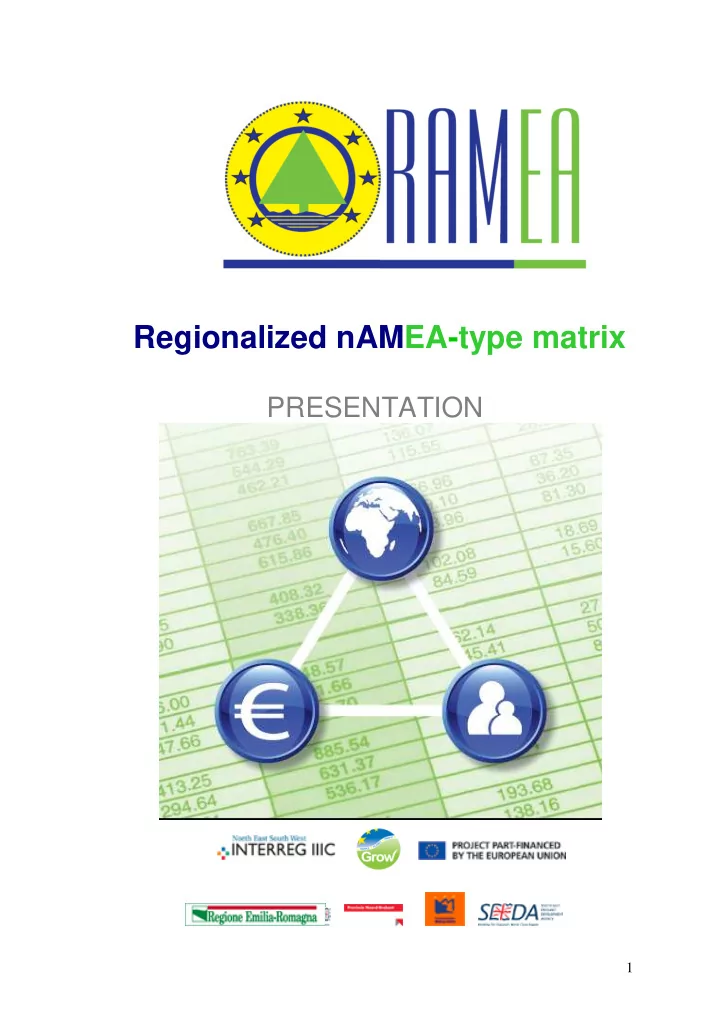

Regionalized nAMEA-type matrix PRESENTATION ���� ������������������������������ ����������������������� ���� ����� ���� 1
the GROW-RAMEA Regions web sites Emilia-Romagna –IT www.regione.emilia-romagna.it Noord Brabant –NL www.brabant.nl Malopolska-PL www.malopolskie.pl South East England-UK www.seeda.co.uk the RAMEA Partners web sites ARPA-ER www.arpa.emr.it Regional Environmental Agency TELOS www.telos.nl the Brabant Centre for Sustainable Development MEERI www.min-pan.krakow.pl/pbs Polish Academy of Science CE www.camecon.com Cambridge Econometrics SCPnet EA www.wwflearning.org.uk/scpnet Sustainable Consumption & Production network- Environment Agency SEEDA www.seeda.co.uk South East England Development Agency SEERA www.southeast-ra.gov.uk South East England Regional Assembly written by Maria Paola DOSI EMILIA-ROMAGNA REGION; GROW Program Regional Coordinator Steering Committee GROW RAMEA Project � the RAMEA’s building Team: �� Paolo CAGNOLI, Michele SANSONI, Francesca LUSSU (Regional Environmental Agency ARPA-ER, IT); Peter J.STAUVERMANN (Brabant Centre for Sustainable Development TELOS, NL) Malgorzata GORALCZYK (Polish Accademy of Science MEERI, PL) Antony BARKER; Mike MAY-GILLINGS(Cambridge Econometrics CE, UK) Carol WILSON (Sustainable Consumption & Production network- Environment Agency SCPnet EA, UK) Graham TUBB (South East England Development Agency SEEDA, UK) Patrick FEEHILY (South East England Regional Assembly SEERA, UK) 2
RAMEA Project’s presentation RAMEA is one of the 16 Projects financed by the INTERREG III C Program 2005-2007 under GROW, the Regional Framework Operation (RFO) whose main topic is to help Regions in RAMEA project & adopting strategies coherent with the Lisbon & Goteborg Agendas goals. Engaging citizens GROW program and integrating environmental systems is key to achieving balanced sustainable regional growth; this encapsulates the aim of the GROW partners who all come from high growth regions but share the ambition of “growth, but not at any cost”. The Regions involved are located at the four corners of the European Union: the nord Europe are represented by the South East England with his Development Agency (SEEDA) - the RFO Lead Partner and the Hollandaise Province of Brabant; the East Europe are represented by Maloposka Region in Poland, while the West and South involve the Spanish Andalusia and the Italian Emilia-Romagna. The GROW projects activities all together aim to “green” economic growth (GREEN GROWTH); increase innovation and competition (BUSINESS GROWTH) while maximising the social potential of society (INCLUSIVE GROWTH). In so doing the GROW partners aim to integrate this “3 pillar (Planet, People, Profit)”sustainable development framework into their regional policies and strategies. The GROW partnership Regions have high performing economies but also a common vision for adopting measures in order to limit as far as possible the undesirable effects connected with high production and consumer society: the increasing pollution of all environmental media and the excessive use of natural resources. At this stage a question arises. What is the most effective way to limit these effects? At first some suitable knowledge tool are needed to help in setting up “sustainable” targets. Toward this specific topic the GREEN GROWTH as well as the other two strands has identified sub-themes and technical specifications used for helping in setting up the project proposal in 2 call for proposal rounds. The relevant sub-theme in our case is the “Resource Management” that includes amongst others the following project outlines: The Economy-wide tools that allows to assess the impacts of economic sectors on the environment and the material flows (environmental accounting) On this specific sub-theme was then submitted on the second round, positively assessed and financed the RAMEA project that involves 4 of the 5 GROW Regions: the South East England (UK) with 4 partner Organisations (SEE Development Agency, the SEE Regional Assembly, the Environmental Agency and Cambridge Econometrics), the Noord Brabant (NL) with Telos ( the Regional Sustainable Development Institute), the Malopolska (PL) with MEERI (the Polish Academy of Sciences Mineral and Energy Economy-Division of Stategic Research ) and the Emilia-Romagna Region (IT) with ARPA (the Regional Environmental Agency) that is the project lead partner. The project timeline is from May 2006 until October 2007. As argued also from technical specifications the Environmental Accounting tools are identified as the reference framework for RAMEA project. In fact the main project output foreseen is the prototype at regional level of one of the most The meaningful and powerful tools that help to bridging the Economy and Environment: the Environmental National Accounting Matrix with Environmental Account (NAM-EA). This is a table recording Accounting monetary and physical flows, developed since 1993 by CBS (Dutch Statistical Institute) and framework now currently updated in many EU Member States, at least at national level. Actually the extended project’s title Regionalized nAMEA-type matrix maybe deserves a better explanation. The NAM is the “matrix version” of the national economic aggregates based on the European System of National Accounts (ESA 95), the standard code used at european level for the value added and other relevant indexes (i.e.Gross Domestic Products, Gross National Income etc.) comparable at global level because it’s fully consistent with the revised world- wide guidelines on national accounting, the System of National Accounts (SNA 93) used for code of measuring and compare the national macro-economy performances. In so far the national accounts is a central framework for the presentation and measurement of the economic stocks and flows within the Economy, that can be represented also in a table or matrix version. For example the production processes can be described by the Supply and Use tables that are two matrices by industry and product describing with great detail the production 3
Recommend
More recommend